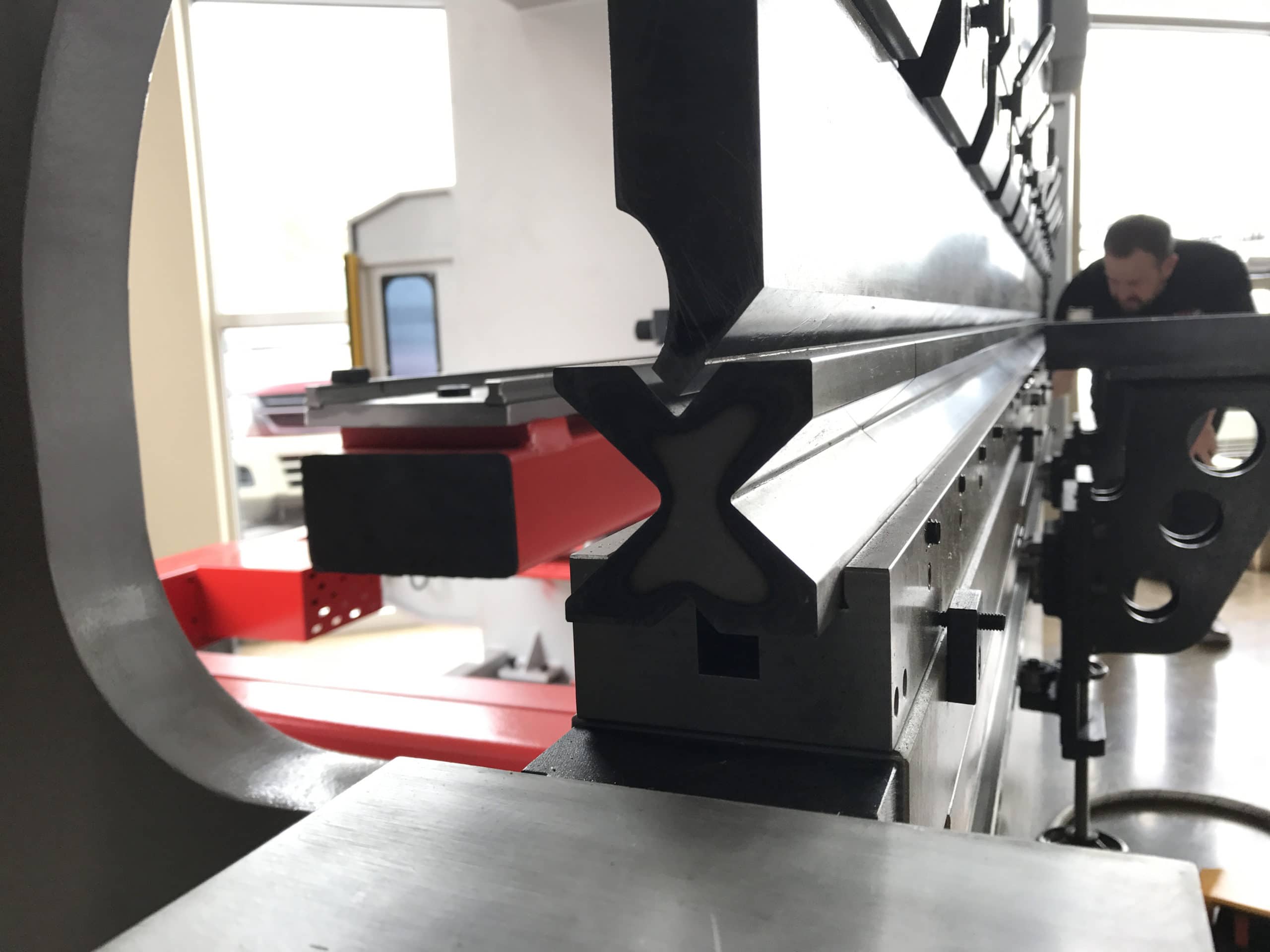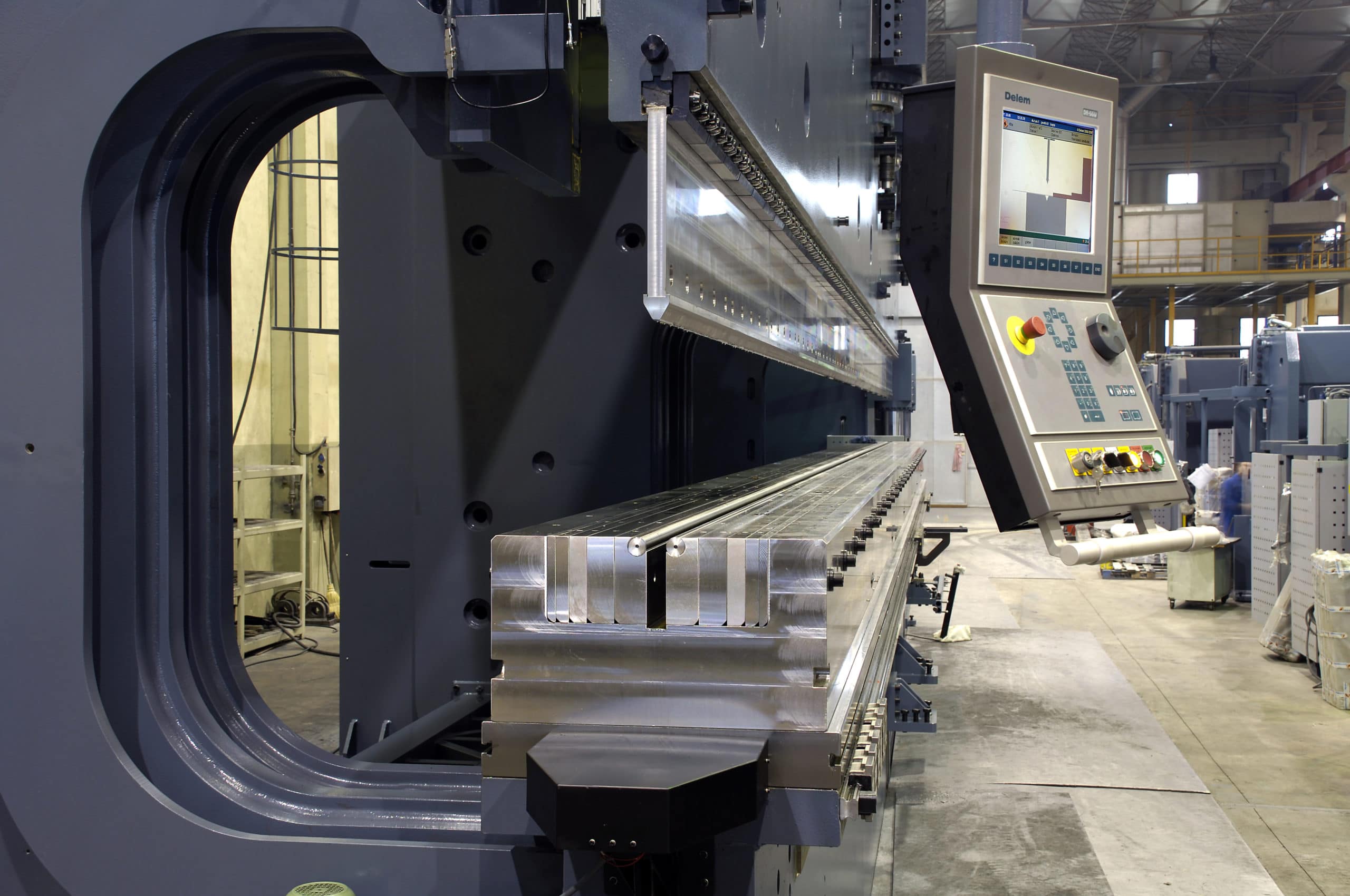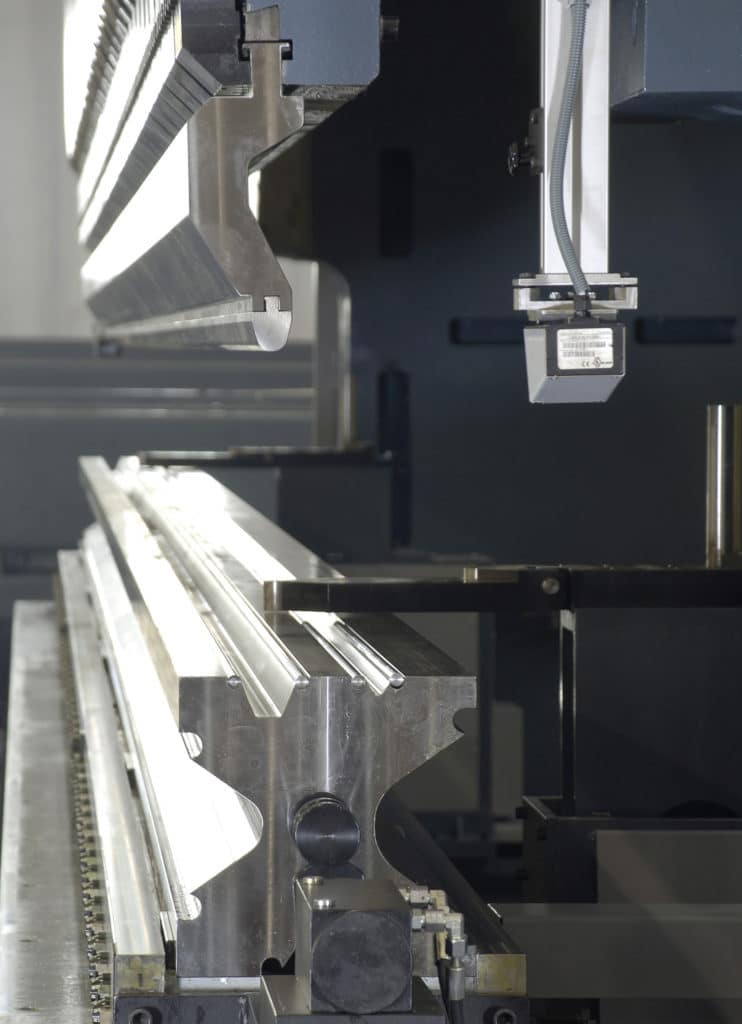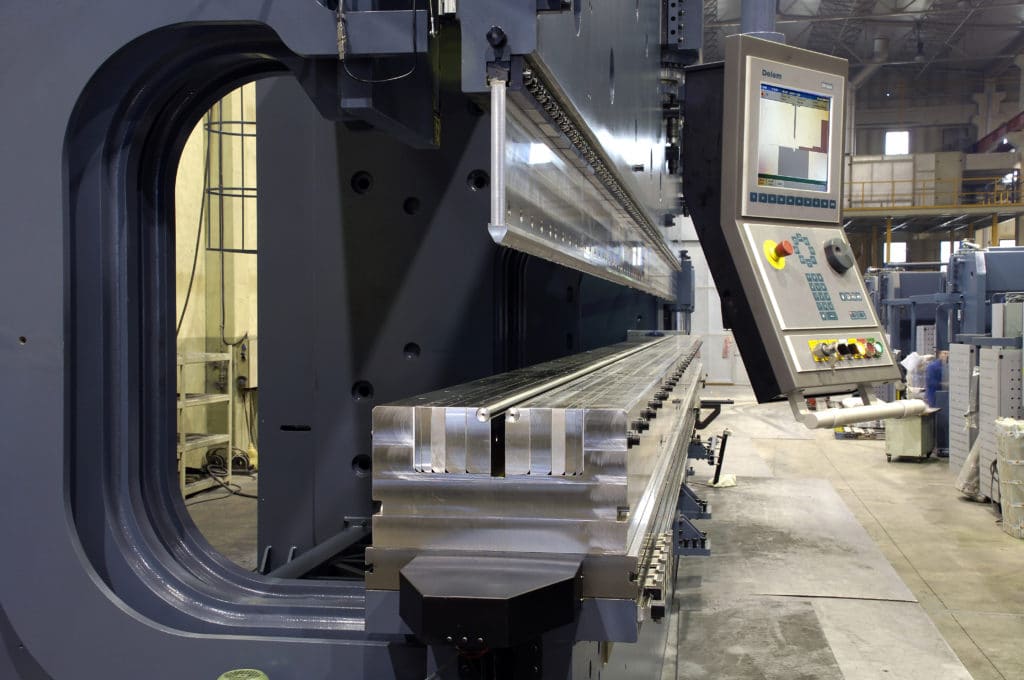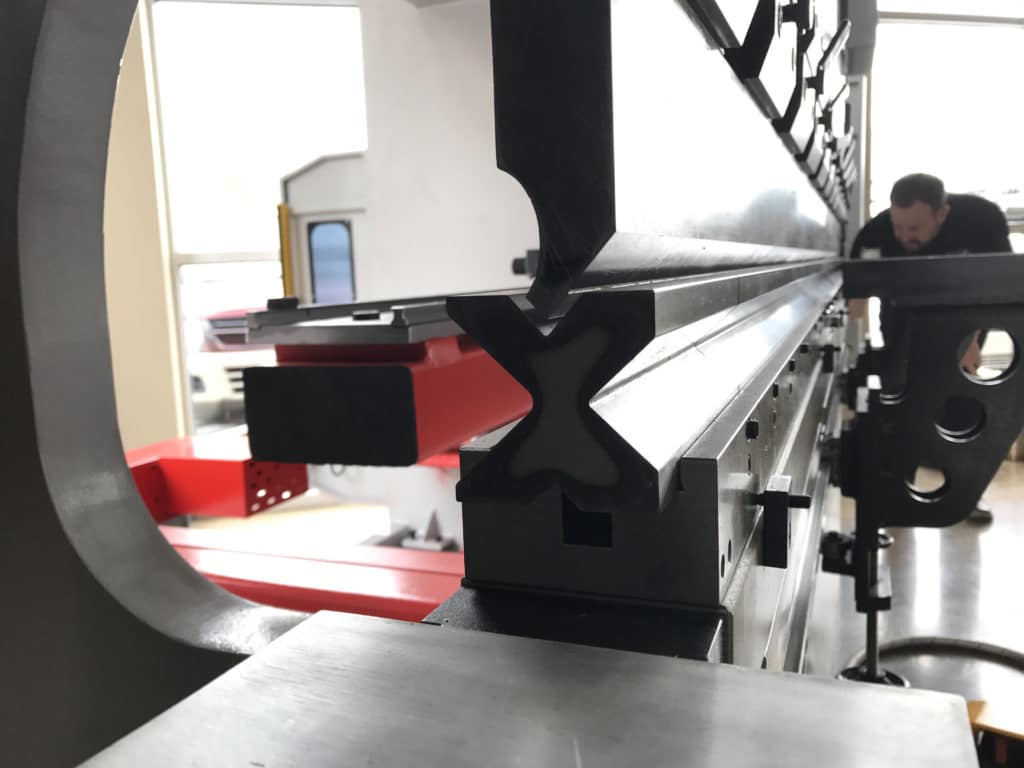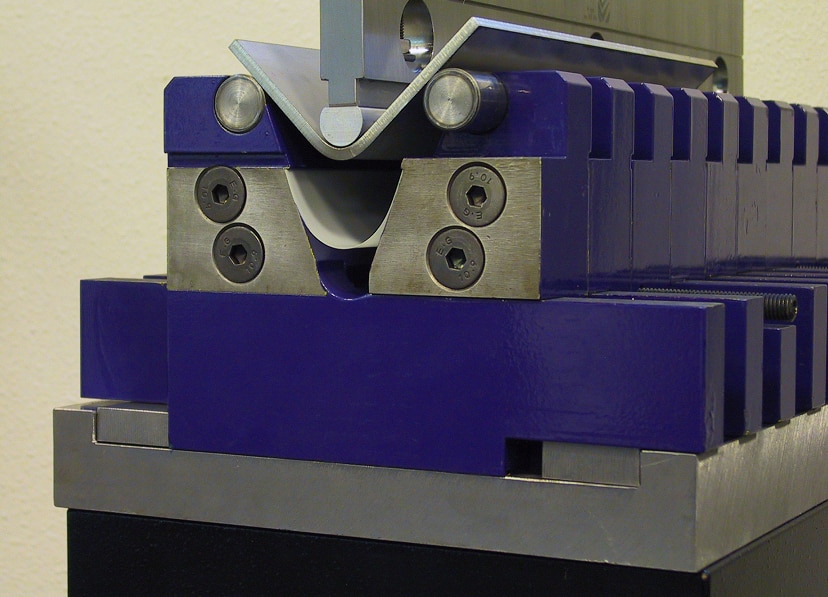It Takes Two to Tango
For all the power a press brake has to offer, its interchangeable punches are truly the most important element of the overall machine. This is because they are the portion that actually interacts with the metal blank during the forming operation to produce the finished part. A punch without a die, however, is frankly not much more than a fancy paperweight. It is the interaction of the two of them working in tandem that shapes the part from both sides.
Just as there are a wide variety of punch types, there are also many different types of dies, and an understanding of their various functions will assist fabricators in selecting the right ones for current and future jobs.
The Rule of Eight
In the art of die selection, there is one principle that is immensely helpful: The Rule of Eight. It states that the die opening in a V-die should be eight times the thickness of the material being bent. This is the formula that is the basis of most press brake bending charts. So, if the material is one-eighth of an inch thick, a one-inch V-die should be ideal. If an exact match isn’t found, the size should be rounded up to the closest available die. It’s not a perfect rule, since metal manufacturing can involve many variables, but it can point a fabricator in the right direction.
Other factors influence the selection of the proper die for a job, such as the radius of the bend. Air bending mild steel with a V-die will form an inside radius around 16% of the opening, so a smaller V-die than prescribed by the Rule of Eight would be necessary for bends requiring a radius tighter than that percentage. Flange length is also a consideration, since the minimum flange that can be formed is around 77% of the size of the V-die. For a shorter flange, changing to a smaller V-die will be necessary.
A metal fab shop that is setting up to use a press brake should purchase a range of V-dies that will cover all of their anticipated needs. The easiest way is to look at the thickest and thinnest materials that will likely be bent and using the Rule of Eight, determine the correctly sized dies to match. Then taking the smallest V-die, the shop manager should double its size to determine the next die, then double that die’s size to determine the one after that, until the largest die is reached. This will give the shop a minimum number of dies to cover most of their bending needs.
The A-Z of Press Brake Die Types
The most common type of press brake die is the V-die. A set of V-dies with variously sized die openings can be used to bend a range of materials in different bend angles, depending on the punches used and the depths they descend into the die during an air-bending operation. Usually, a V-die consists of just a single V-shaped groove cut into one side of a long block of metal, but occasionally shops will purchase a 2V-die that has two parallel grooves of different sizes in machined in a single side that expedite continuous work without retooling.
Four-way die blocks are also very popular. These have a different V-die machined in each of the separate sides to make job changeovers simpler with just a rotation of the die. (The rotation is often accomplished by using the ram to lift the block with chains attached to both outside edges and rotating the die by hand in mid-air before being lowered.) These four-sided die blocks are also known as multi-V dies, and some variants will have more than one groove to a side.
Along with the V-die, a variety of different dies have been created to accommodate different kinds of bends, so it behooves fabricators to get a passing familiarity with them so that they can determine the best route for producing all the challenging jobs they acquire in the future. Here are some of the major ones:
- 90-degree dies are, as the name implies, used for making 90° bends, usually in bottom bending where a greater tonnage is used than in air bending. The size of the die opening can vary based on material thickness.
- Acute angle dies are used in air-bending for creating angled bends that are smaller than 90 degrees. These dies can also produce 90° and obtuse angles, based on how deep the punch descends into them.
- Beading dies are used with matching punches to produce a bead in the finished part to reinforce it.
- Box dies are used for forming rectangular boxes in conjunction with segmented punches to accommodate different side lengths.
- Channel dies are used to form flat-bottomed channels with two angles in a single operation by using a broad flat punch.
- Combination bend-and-hem dies can form parts with a hemmed edge in a single set-up. The die features a flat top on either side of a narrow die opening, while a matching punch has a flat-bottomed extension sticking out from its upper edge. After an acute bend is made, the part is then immediately turned horizontally for the two flat edges to compress the hem in a second operation.
- Corrugating dies have a wavy rounded or flat-bottomed shape to create a corrugated pattern in the metal.
- Curling dies form a curled edge on the part.
- Flattening dies are another name for hemming dies and are used to close a previously formed acute angle to a smaller degree or flatten as a hem.
- Gooseneck dies are designed to work with gooseneck punches, which allow for the clearance of already formed flanges.
- Hemming dies are used to flatten a part after a 30° or other very acute bend has been made to form a hem. They are flat-topped and are used with a matching “hammer” punch that is also flat. Combination bend-and-hem punch and die sets can make the initial bend and then have their flat outer edges used to hem the part in a second operation without additional setup. Two stage hemming dies are spring-loaded two section dies and work with a standard punch. The upper part of the die has a V-opening and is used to form the bend normally, but it and the lower part have flat surfaces extending outward that are brought together under the tonnage of the ram pushing down, so a hem can be made between them in a second immediate operation.
- Joggle die sets are adjustable offset dies used to create matching parts that are joined in a manner that provides a smooth and continuous outer surface, such as in aircraft construction. They can be adjusted through shimming or with a set screw.
- Multiple bend dies and their matching punches are built in the shape of the desired profile and create two or more bends in a single operation. Offset dies are a common type of multiple bend dies.
- Offset dies are used with a matching punch to bend two angles in one stroke to produce a Z shape. Offset dies not only speed production, but accuracy is greatly increased since the bends are kept completely parallel.
- Radius dies are used with a rounded punch to form a radiused bend.
- Rib-forming dies are used to make radius rib channels and V-ribs.
- Rocker-type dies support the workpiece throughout a bend when using a rocker insert in the punch. They allow for some sideways motion to avoid clearance difficulties.
- Rotary dies and their punches work by using a rotating insert in either the upper or lower tool to create a bend over the anvil-like opposite tool. They require less tonnage than standard bending and decrease the friction that is applied to the workpiece, leaving no marks like a regular V-die would.
- Seaming dies allow a seam to be produced in sheets and tubes.
- Standing seam dies are part of specialized punch and die sets that create a vertical hem, or standing seam, that is perpendicular to the rest of the finished part.
- Tipped angle dies have different angles on either side of the V-groove and are used to help ram clearance on deep channels and for forming shorter flanges than conventionally would be possible.
- Tube-forming dies and pipe-forming dies are similar to curling dies and are used to shape tubes following an initial operation that bends and rolls up the edges of a workpiece.
- U-bend dies have a rounded bottom, but otherwise are similar to channel-forming dies and are used for radius U-bends.
- Urethane dies are used to bend without leaving marks in parts that require better surface quality, though they often are somewhat less accurate than steel dies. Steel dies with nylon inserts can also be used to minimize scratching.
- Wiping dies are similar to rocker-type dies or rotary dies and are used with matching punches for wiping a radius on the edge of a sheet.
- Z-bend dies are another common name for offset dies because of the shape of the resulting part that is made in a single bend.
There are other factors to keep in mind as well. A fabricator may want to consider buying flame-hardened tooling to extend wear life or for extra durability. Just as there are different clamping styles for press brake punches, there are also differences in otherwise identical bottom dies. For example, European-style dies have special tangs that hold them in the die holders for extra precision.
A Die for Every Occasion
The wise press brake operator will learn everything he or she can about punches and dies so that informed decisions can be made with each job as well as when it is time to upgrade a press brake’s tooling.
Understanding the variety of available press brake dies and keeping up with new styles opens up a wider range of opportunities in metal bending for fabricators wanting to maintain a competitive advantage in the market.


